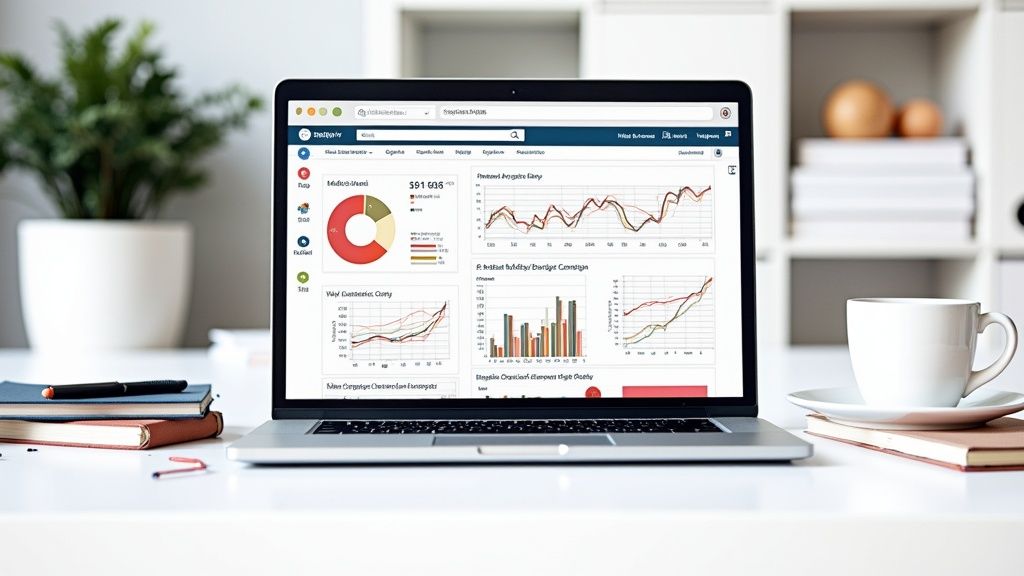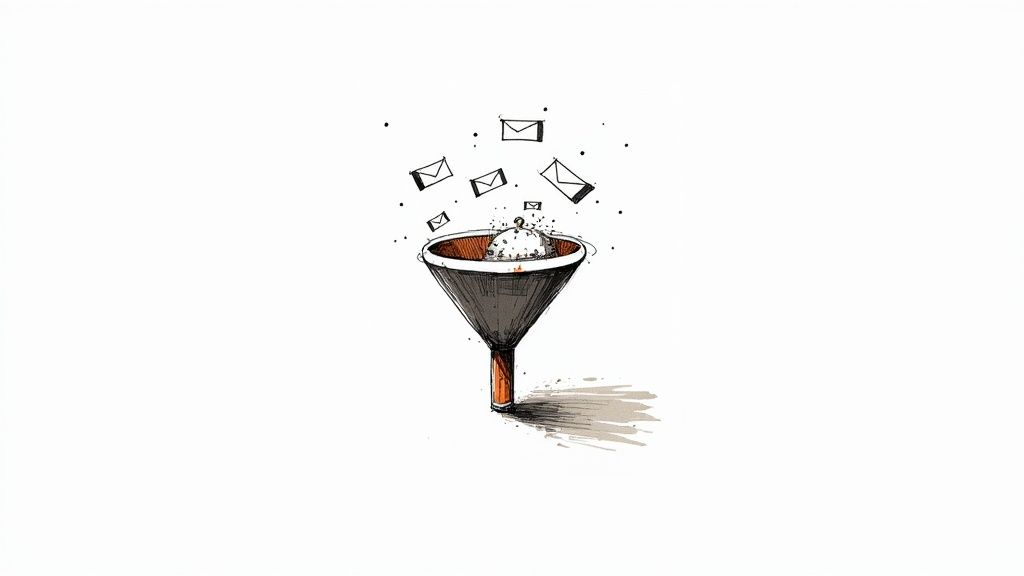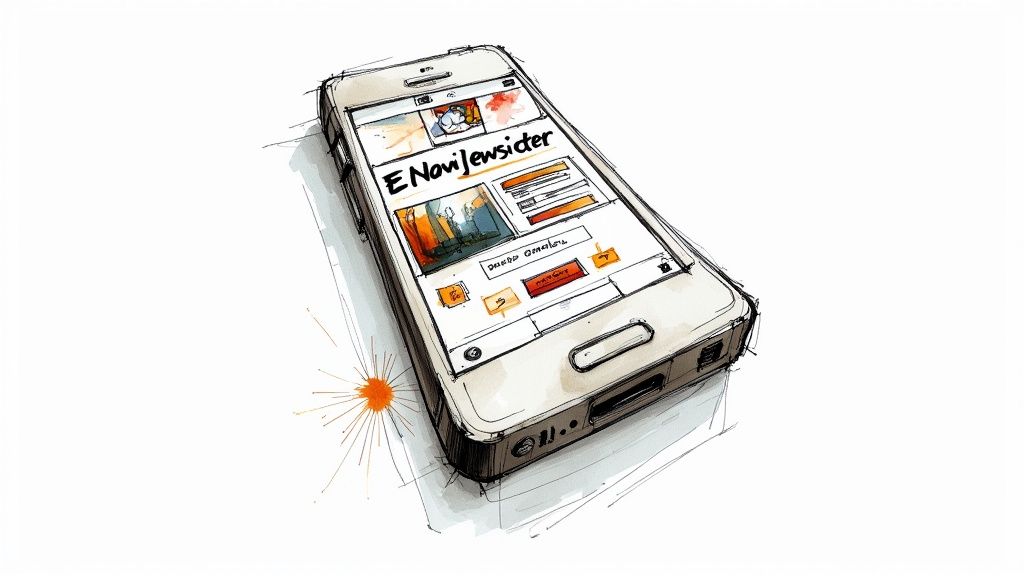Email Marketing: Best Practices for 40X ROI
Building Your Email Marketing Foundation

Every successful email marketing strategy needs solid foundational elements. Email continues to be one of the most effective marketing channels available, consistently delivering impressive returns on investment. Research shows that businesses typically see $36 in returns for every$ 1 spent on email marketing - that's a 3,600% ROI. These numbers make a strong case for mastering email marketing fundamentals and best practices.
Setting Realistic ROI Targets
While those ROI numbers are exciting, it's important to set achievable goals when starting out. Think of email marketing like training for a marathon - you build up your endurance and speed gradually over time. Start by setting reasonable benchmarks based on your industry and business size. For new email programs, aiming for a 30:1 ROI might make more sense than immediately expecting the 36:1 industry average. Track your progress carefully and adjust your approach based on what the data tells you.
Choosing the Right Metrics
Success in email marketing depends on measuring what matters most for your specific goals. Open rates, click-through rates, and conversion data each tell different parts of the story. If you're focused on growing brand awareness, you'll want to pay special attention to open rates and overall engagement. For sales-driven campaigns, conversion tracking and revenue per email become your key indicators. Pick the metrics that align with your business objectives and use them to guide your decision-making.
Building Scalable Programs
A well-designed email program should grow smoothly alongside your business. This means creating systems and processes that work just as well with 100,000 subscribers as they do with 1,000. Smart automation helps you send personalized, timely messages without getting overwhelmed as your list grows. For example, you might set up behavior-triggered emails that automatically welcome new subscribers or follow up after purchases. Combine this automation with targeted content for different audience segments to maintain personal connections at scale. When you build these capabilities into your program from the start, you create a strong foundation for long-term success.
Mastering the Art of Email Timing
Success in email marketing requires more than writing great content and dividing up your audience - you need to understand exactly when to hit send. Getting email timing right means thinking deeply about your subscribers' reading habits and when they're most likely to engage with your messages. You'll need to find that perfect balance between staying top-of-mind and avoiding overwhelming your audience.
Finding Your Optimal Sending Frequency
Every successful email program has to solve the frequency puzzle. Send too few messages, and you miss chances to connect and drive results. Send too many, and people start hitting unsubscribe. The good news is that research points to a clear sweet spot. Data shows that sending 9-16 emails each month generates nearly 4x better returns compared to monthly emails (46:1 ROI versus 13:1). These numbers confirm that regular, valuable emails work better than sporadic outreach.
Balancing Growth With Subscriber Satisfaction
Just like a garden needs the right amount of water, your email list needs the right amount of contact. Too little communication leaves subscribers forgetting about you, while too much drives them away. Start by studying how your audience responds to your current sending patterns. Keep an eye on your open rates, click rates, and unsubscribes. If you notice engagement dropping after increasing frequency, that's a red flag that you may be overdoing it.
Practical Frameworks for Testing Email Timing
The best way to dial in your timing is through careful testing with different audience segments. For example, you might find your long-time customers want to hear from you more often, while new subscribers prefer fewer touchpoints. This targeted approach lets you customize frequency based on what works for each group. Make sure to also test different subject lines and preview text within these segments to keep improving. Regular testing and tweaking based on results will help you maintain strong performance over time.
Creating Genuinely Personal Email Experiences

The key to successful email marketing goes beyond just optimizing send times and frequency - it's about creating authentic connections with your subscribers. Rather than simply adding a first name to your emails, focus on crafting messages that truly resonate with each recipient's interests and needs. Companies that get this right see impressive results - some have increased revenue by up to 760% through smart personalization approaches. Let's explore how to create these meaningful email experiences.
Leveraging Customer Data Effectively
Understanding your audience starts with basic information like demographics, but the real insights come from analyzing behavior patterns. Track which products customers view, what content they read, and how they interact with your emails. This data helps you segment your audience into meaningful groups. For example, if someone frequently browses running shoes on your site, send them targeted emails featuring new athletic footwear releases or helpful training content. This approach shows customers you understand their interests and helps build stronger relationships.
Crafting Dynamic Content That Resonates
Your email content should shift and adapt based on who's reading it. Think of it like creating a personalized magazine - each subscriber sees images, product suggestions, and content that matches their preferences. A running enthusiast might see trail running shoes and outdoor gear, while a gym-goer receives workout equipment recommendations. The same principle applies to subject lines - mentioning specific products or topics your reader cares about will grab their attention much better than generic messages.
Building Automated Workflows That Scale
Smart personalization doesn't mean creating individual emails by hand. Set up automated sequences that trigger based on subscriber actions. When someone joins your list, they automatically receive a welcome series that learns about their interests. If they abandon items in their cart, they get a friendly reminder with related products they might like. These automated workflows let you maintain personal connections even as your subscriber list grows larger.
Real-World Examples and Implementation
Take a clothing store that adjusts its email content based on shopping history. Someone who loves dresses sees new formal wear collections, while an activewear fan gets updates about workout clothes. Or consider how a software company personalizes its onboarding - when new users get stuck on setup steps, they receive specific guidance to help them move forward. These examples show how understanding your audience and sending relevant messages leads to better engagement and stronger results.
Segmentation Strategies That Actually Work
Adding personal touches to emails is just the beginning. The real magic happens when you thoughtfully divide your email list into targeted segments that let you send truly relevant messages to each group. Top marketers consistently point to segmentation as their secret weapon - and the results show why. When you can match the right content with the right audience at the right moment, your emails simply work better.
Understanding the Power of Segmentation
Think of segmentation as organizing your subscribers into natural groups based on what they have in common - their interests, needs, and how they behave. This lets you move beyond generic mass emails to create messages that really connect with each segment. The impact can be dramatic - some companies have seen revenue jump up to 760% just by sending more targeted emails. This huge lift comes from delivering content that actually matters to people, which builds stronger relationships and motivates them to take action.
Behavioral Segmentation: Targeting Actions
One of the most useful ways to segment is based on how subscribers actually interact with your business. You can group people according to what they buy, which pages they visit on your site, and how they engage with your emails. This tells you exactly what interests them, so you can follow up appropriately. For example, if someone keeps looking at hiking boots on your website, you can automatically send them emails about new outdoor gear, trail guides, or special deals on hiking equipment. Since you know they're already interested in hiking, they're much more likely to buy.
Demographic and Engagement-Based Segmentation
While behavior gives great insights, looking at demographics and engagement levels adds another useful layer. Demographics like age, location, and job role help you customize your message approach. A clothing store might show different styles to 20-somethings versus 50-somethings, for instance. Engagement segments help you treat active and inactive subscribers differently. Your most engaged readers might get exclusive previews or early access to sales as a reward, while less active ones could receive "We miss you" campaigns or fewer emails to avoid overwhelming them.
Avoiding Segmentation Pitfalls
Even with all its benefits, segmentation requires a balanced approach. Creating too many tiny segments quickly becomes messy and hard to manage. Start with broader groups first, then make them more specific as you learn more about your audience. Also, remember that segments need regular updates since people's interests and behaviors change over time. Keep your segments current and flexible to maintain strong results from your email marketing efforts.
Designing for Today's Mobile-First World

Email marketing success depends heavily on mobile optimization, as most people now check emails on their phones and tablets. Recent data shows that around 60% of all email opens happen on mobile devices. This means your emails must look great and work smoothly on smaller screens to reach your audience effectively.
Understanding the Mobile Mindset
Think about how you check emails on your phone - you're probably scanning quickly while commuting, waiting in line, or multitasking. Your subscribers do the same. Half of mobile users immediately delete emails that don't display properly on their devices. Poor mobile design doesn't just mean missed opportunities - it can damage your brand reputation and lead to unsubscribes. When subscribers have a frustrating experience with your emails on mobile, they're less likely to engage with your future messages.
Implementing Responsive Design
The key to great-looking emails on any device is responsive design. This approach ensures your email automatically adjusts its layout and formatting to match different screen sizes. For example, what appears as three columns on a desktop monitor might shift to a single column on a phone screen, making it easy to read. These automatic adjustments help maintain a smooth, consistent experience whether someone opens your email on their laptop, tablet, or phone.
Creating Mobile-Friendly Content
Mobile-friendly design goes beyond just responsive layouts. Your content needs to be easy to read and navigate on small screens. Use short paragraphs, clear headings, and plenty of white space. Make sure buttons are large enough to tap easily with a thumb - nothing frustrates mobile users more than tiny, hard-to-click elements. Also, keep image file sizes small to ensure quick loading times on mobile networks. Slow-loading emails often get closed before they're even read.
The Importance of Cross-Device Testing
Before sending any email campaign, test how it looks across different devices and email apps. What works perfectly on your computer might break on someone else's phone. Many email testing tools let you preview your messages on various screen sizes and email clients. This testing step helps catch formatting issues early, ensuring every subscriber gets a properly formatted email that looks professional on their preferred device. Taking time to test thoroughly leads to better engagement and stronger connections with your audience.
Scaling Success Through Smart Automation

Email marketing success requires more than great content and audience targeting - it needs smart automation to reach its full potential. When you automate key processes, you can deliver personalized experiences to every subscriber while saving time and resources. The right automation tools let you stay personal and relevant even as your audience grows into the thousands or millions.
Automating the Welcome Experience
Your welcome emails set the tone for your entire relationship with new subscribers. A well-designed welcome sequence introduces your brand and value naturally, while encouraging engagement through strategic calls-to-action. For example, you might start with a warm thank you note, then showcase your most popular offerings, and follow up with an exclusive discount to motivate that first purchase. This automated series nurtures leads effortlessly - no manual work required.
Behavior-Triggered Email Magic
Automated emails can respond intelligently to subscriber actions, creating perfect-timing touchpoints throughout the customer journey. When someone abandons their shopping cart, a gentle reminder email can bring them back to complete the purchase. After they buy, automated follow-ups can suggest related products they'll love. These behavior-based messages feel natural and personal while driving real results for your business.
Streamlining Internal Processes with Automation
Your team benefits from automation too. Instead of manually managing lists, scheduling emails, and pulling reports, automated workflows handle the routine tasks. This frees up your marketers to focus on strategy, creativity, and optimization. Simple automations for things like welcome series, list cleanup, and performance tracking add up to major time savings.
Measuring the Impact of Automation
Like any marketing initiative, automated campaigns need regular monitoring and optimization. Track core metrics such as open rates, clicks, conversions, and revenue to understand what's working. Use the data to refine your automated flows - test different subject lines, adjust sending times, and improve content based on subscriber engagement. Small improvements compound over time when your campaigns run automatically.
Boost your customer engagement and streamline your operations with Sitebot's AI-powered chatbots. Integrate seamlessly with your website and other platforms to provide instant support, generate leads, and build stronger relationships. Visit https://sitebot.co to learn more and transform your customer experience today!


